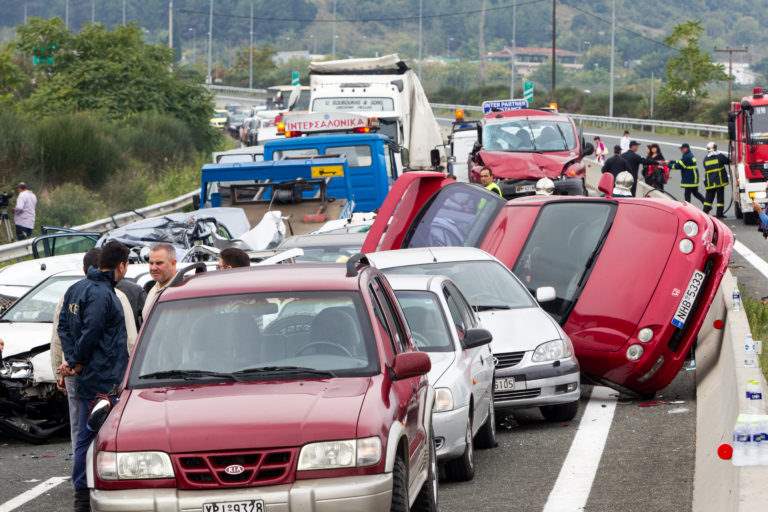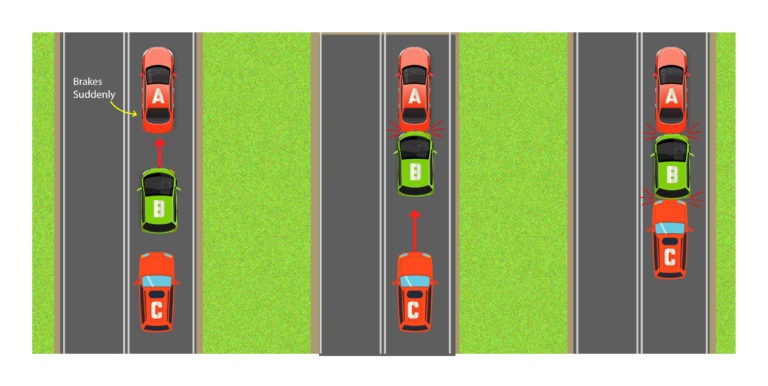Not too long ago in New Port Richey, Florida, a driver suffering from a medical emergency caused a traumatic five-car chain reaction crash, injuring five and resulting in extensive road closures [1]. According to reports, the driver had suffered an unexpected seizure, which caused her to depress the gas pedal and accelerate. The driver's passenger then made a split-second decision to steer the vehicle into oncoming traffic in order to avoid hitting vehicles stopped at a red light. This in-turn caused the multi-car collision. What a scary and random situation! With multiple cars involved, injuries sustained, and potential defenses to liability, this real-life accident can be used as a test case for answering the question: Who is liable for a multi-car crash in Florida?
What is a multi-car collision?
A multiple vehicle collision (aka multi-car collision, vehicle pile-up, or chain-reaction crash) is a traffic accident that involves more than two vehicles, ranging from three to perhaps dozens. Generally, these incidents occur in high volume, high speed areas, such as highways or major city roads. Pile-ups are most often caused by a few conditions:- Following too close
- Low-visibility due to weather
- Reduced traction due to icy or wet roads

Florida Comparative Fault Law
Each state adheres to its own laws for determining fault in multi-car collisions. While some states prohibit recovering damages if you were more than 50% liable for the accident, a small number of states will prohibit recovery if you were even 1% at fault for the accident. Florida, however, follows what is known as a “pure comparative fault” system.
Florida law states that “contributory fault chargeable to the claimant diminishes proportionately the amount awarded as economic and non-economic damages for an injury attributable to the claimant's contributory fault, but does not bar recovery” [3]. In other words, if your personal injury attorney successfully litigates your claims, then whatever amount you are awarded for injuries, say $10,000, is reduced by your percentage of fault. For example, if the jury found that you were 10% at fault for the accident, then you would only be able to recover $9,000, a 10% reduction from the original $10,000 reward.Further, Florida has abolished “joint and several” liability, which is an old legal principle that allowed you to choose who you wished to recover the full amount of damages from [4]. For example, let's say you were driving Car A and were injured in an accident caused by both Car B and Truck C. The jury determines that you are 0% at fault for your injuries, but that Car B is 90% at fault and Truck C is 10% at fault. If Truck C had better insurance than Car B, you used to have the right to demand that Truck C pay ALL of your damages, despite sharing fault with Car B. This is no longer the case in Florida, and as such, every driver involved in a multi-car collision will only be responsible for the percentage of fault attributable to them. So in this example, Car B will be responsible for 90% of damages and Truck C will be responsible for the other 10%.

When a Driver Suffers a Medical Emergency
If you are involved in a car crash or truck accident, including a multi-vehicle accident, the primary legal ground for recovering damages is a cause of action called “negligence.” In order to show that another driver was negligent, your attorney must prove the following elements:
Duty: The driver had a duty to others to operate his or her motor vehicle in a safe manner and in accordance with Florida law;
Breach: The driver failed to take measures to operate the vehicle in a safe, reasonable, or legal manner;
Causation: As a result of the driver's breach, you were involved in a traffic accident, and
Damages: As a result of the accident, you sustained injuries or other compensable damages..
As with the driver who caused the New Port Richey multi-car accident last year, if you suffer from an unexpected medical emergency, you may not be held liable for causing a multi-car accident. The reason is that a potential plaintiff may not be able to prove that you were negligent, as it is possible you did not fail to take measures to ensure the safety of others. For example, if you are generally a healthy individual, have never suffered from seizures before, did not engage in any behavior, such as drug use, which would initiate a seizure, and had no family history of seizures, then you may not have breached any duty to other drivers. If, however, you had suffered from seizures in the past and neglected to take your medication that morning, then you consciously endangered other drivers by getting behind the wheel.
In keeping with the case at hand, the passenger who took control of the driver's vehicle after her medical emergency stated that she drove into oncoming traffic in order to avoid hitting the vehicles stopped in front of her. Could this be a defense to liability? Probably not, because she endangered just as many lives by driving into oncoming traffic. However, there are some situations in which avoidance of a more severe accident is a potential defense to liability. For example, if you are driving down the road and a child suddenly runs into the street for his ball, knowing you cannot stop in time you may choose to quickly change lanes even though you know you will hit the car next to you. This may cause a chain reaction that results in extensive injuries and property damage, but you also may have saved the life of a child. This is called the “necessity” defense, and it is a potential defense to liability if applied by an experienced Florida personal injury attorney.
Contact a New Port Richey Car Accident Attorney Today for Free Case Analysis
Whether you are the driver at the front, middle, or tail end of a multi-car collision, determining liability can be a complex endeavor. It must be determined who was speeding, if someone was following another too closely, or if a potential defense to liability exists in order to apportion fault. This can take intensive research and investigation, especially because Florida has abolished joint and several liabilities. This means that, in order to recover for the full damages suffered in a multi-car collision, the jury must divide liability to every driver involved in the crash.But don't let yourself be overwhelmed because the Dolman Law Group Accident Injury Lawyers, PA is your trusted personal injury firm in New Port Richey. With experience handling complex multi-car collisions, our attorneys are here to ensure you get all of the compensation you deserve without the hassle. Contact us today for a free, no-risk consultation.
Dolman Law Group Accident Injury Lawyers, PA 5435 Main Street New Port Richey, FL 34652 (727) 477-9660 https://www.dolmanlaw.com/new-port-richey-auto-accident-attorney/- https://www.abcactionnews.com/news/region-pasco/port-richey/medical-emergency-causes-5-car-chain-reaction-crash-in-port-richey
- https://en.wikipedia.org/wiki/Multiple-vehicle_collision
- https://www.leg.state.fl.us/statutes/index.cfm?App_mode=Display_Statute&URL=0700-0799/0768/Sections/0768.81.html
- JOINT AND SEVERAL LIABILITY IN FLORIDA: ARE REPORTS OF ITS DEMISE GREATLY EXAGGERATED?